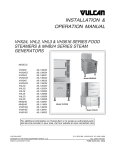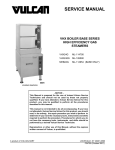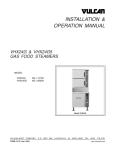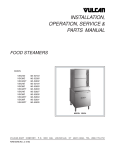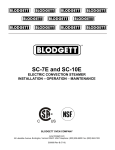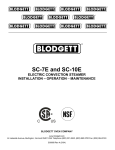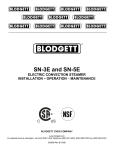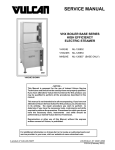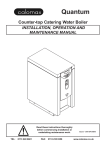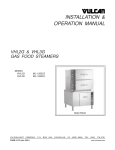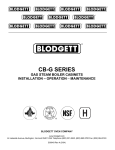Download Vulcan-Hart MHB24G Specifications
Transcript
INSTALLATION & OPERATION MANUAL MHB24G MODULAR GAS STEAM BOILER MODEL MHB24G ML-114954 Model MHB24G VULCAN-HART COMPANY, FORM 31181 (Apr. 2001) P.O. BOX 696, LOUISVILLE, KY 40201-0696, TEL. (502) 778-2791 www.vulcanhart.com IMPORTANT FOR YOUR SAFETY THIS MANUAL HAS BEEN PREPARED FOR PERSONNEL QUALIFIED TO INSTALL GAS EQUIPMENT, WHO SHOULD PERFORM THE INITIAL FIELD START-UP AND ADJUSTMENTS OF THE EQUIPMENT COVERED BY THIS MANUAL. POST IN A PROMINENT LOCATION THE INSTRUCTIONS TO BE FOLLOWED IN THE EVENT THE SMELL OF GAS IS DETECTED. THIS INFORMATION CAN BE OBTAINED FROM THE LOCAL GAS SUPPLIER. IMPORTANT IN THE EVENT A GAS ODOR IS DETECTED, SHUT DOWN UNITS AT MAIN SHUTOFF VALVE AND CONTACT THE LOCAL GAS COMPANY OR GAS SUPPLIER FOR SERVICE. FOR YOUR SAFETY DO NOT STORE OR USE GASOLINE OR OTHER FLAMMABLE VAPORS OR LIQUIDS IN THE VICINITY OF THIS OR ANY OTHER APPLIANCE. WARNING: IMPROPER INSTALLATION, ADJUSTMENT, ALTERATION, SERVICE OR MAINTENANCE CAN CAUSE PROPERTY DAMAGE, INJURY OR DEATH. READ THE INSTALLATION, OPERATING AND MAINTENANCE INSTRUCTIONS THOROUGHLY BEFORE INSTALLING OR SERVICING THIS EQUIPMENT. IN THE EVENT OF A POWER FAILURE, DO NOT ATTEMPT TO OPERATE THIS DEVICE. © VULCAN-HART COMPANY 1998, 2001 –2– TABLE OF CONTENTS GENERAL . . . . . . . . . . . . . . . . . . . . . . . . . . . . . . . . . . . . . . . . . . . . . . . . . . . . . . . . . . . . 4 INSTALLATION . . . . . . . . . . . . . . . . . . . . . . . . . . . . . . . . . . . . . . . . . . . . . . . . . . . . . . . Unpacking . . . . . . . . . . . . . . . . . . . . . . . . . . . . . . . . . . . . . . . . . . . . . . . . . . . . . . . Location . . . . . . . . . . . . . . . . . . . . . . . . . . . . . . . . . . . . . . . . . . . . . . . . . . . . . . . . . Installation Codes and Standards . . . . . . . . . . . . . . . . . . . . . . . . . . . . . . . . . . . . Leveling . . . . . . . . . . . . . . . . . . . . . . . . . . . . . . . . . . . . . . . . . . . . . . . . . . . . . . . . . Gas Connection . . . . . . . . . . . . . . . . . . . . . . . . . . . . . . . . . . . . . . . . . . . . . . . . . . . Testing the Gas Supply System . . . . . . . . . . . . . . . . . . . . . . . . . . . . . . . . . . . . . . Flue Connection . . . . . . . . . . . . . . . . . . . . . . . . . . . . . . . . . . . . . . . . . . . . . . . . . . Electrical Connection . . . . . . . . . . . . . . . . . . . . . . . . . . . . . . . . . . . . . . . . . . . . . . Plumbing Connections . . . . . . . . . . . . . . . . . . . . . . . . . . . . . . . . . . . . . . . . . . . . . Water Supply Connections . . . . . . . . . . . . . . . . . . . . . . . . . . . . . . . . . . . . . . . . . . Drain Connection . . . . . . . . . . . . . . . . . . . . . . . . . . . . . . . . . . . . . . . . . . . . . . . . . . Water Quality . . . . . . . . . . . . . . . . . . . . . . . . . . . . . . . . . . . . . . . . . . . . . . . . . . . . . Connection of Cooking Equipment to the Boiler . . . . . . . . . . . . . . . . . . . . . . . . . Start-up Test Run . . . . . . . . . . . . . . . . . . . . . . . . . . . . . . . . . . . . . . . . . . . . . . . . . Automatic Blowdown . . . . . . . . . . . . . . . . . . . . . . . . . . . . . . . . . . . . . . . . . . . . . . . Sequential Start-up . . . . . . . . . . . . . . . . . . . . . . . . . . . . . . . . . . . . . . . . . . . . . . . . 4 4 4 5 5 5 5 6 6 6 6 7 7 7 8 8 8 OPERATION . . . . . . . . . . . . . . . . . . . . . . . . . . . . . . . . . . . . . . . . . . . . . . . . . . . . . . . . . . 9 Controls — Boiler . . . . . . . . . . . . . . . . . . . . . . . . . . . . . . . . . . . . . . . . . . . . . . . . . 9 Boiler . . . . . . . . . . . . . . . . . . . . . . . . . . . . . . . . . . . . . . . . . . . . . . . . . . . . . . . . . . 10 Preheat. . . . . . . . . . . . . . . . . . . . . . . . . . . . . . . . . . . . . . . . . . . . . . . . . . . . . . . . . 10 Operating Boiler . . . . . . . . . . . . . . . . . . . . . . . . . . . . . . . . . . . . . . . . . . . . . . . . . 10 Extended Shutdown . . . . . . . . . . . . . . . . . . . . . . . . . . . . . . . . . . . . . . . . . . . . . . 10 Cleaning . . . . . . . . . . . . . . . . . . . . . . . . . . . . . . . . . . . . . . . . . . . . . . . . . . . . . . . . 11 Boiler Blowdown . . . . . . . . . . . . . . . . . . . . . . . . . . . . . . . . . . . . . . . . . . . . . . . . . 11 Guidelines for Maintaining Stainless Steel Surfaces . . . . . . . . . . . . . . . . . . . . 11 MAINTENANCE . . . . . . . . . . . . . . . . . . . . . . . . . . . . . . . . . . . . . . . . . . . . . . . . . . . . . . Boiler Blowdown . . . . . . . . . . . . . . . . . . . . . . . . . . . . . . . . . . . . . . . . . . . . . . . . . Boiler Pressure Relief Valve . . . . . . . . . . . . . . . . . . . . . . . . . . . . . . . . . . . . . . . . Air Intake to the Blower . . . . . . . . . . . . . . . . . . . . . . . . . . . . . . . . . . . . . . . . . . . . Scale Related Maintenance . . . . . . . . . . . . . . . . . . . . . . . . . . . . . . . . . . . . . . . . Water Level Gauge . . . . . . . . . . . . . . . . . . . . . . . . . . . . . . . . . . . . . . . . . . . . . . . Flue . . . . . . . . . . . . . . . . . . . . . . . . . . . . . . . . . . . . . . . . . . . . . . . . . . . . . . . . . . . Boiler Inspection Plate . . . . . . . . . . . . . . . . . . . . . . . . . . . . . . . . . . . . . . . . . . . . 11 11 11 11 12 12 12 12 TROUBLESHOOTING . . . . . . . . . . . . . . . . . . . . . . . . . . . . . . . . . . . . . . . . . . . . . . . . . 12 Service and Parts Information . . . . . . . . . . . . . . . . . . . . . . . . . . . . . . . . . . . . . . . . . . . 12 –3– Installation, Operation, and Care of MODEL MHB24G MODULAR GAS STEAM BOILER KEEP THIS MANUAL FOR FUTURE USE GENERAL Vulcan gas steam boilers are produced with quality workmanship and material. Proper installation, usage, and maintenance of your boiler will result in many years of satisfactory performance. It is suggested that you thoroughly read this entire manual and carefully follow all of the instructions provided. The boiler can be built for natural gas or propane with gas input rating of 270,000 BTU/hr. Boiler is rated high efficiency. Boiler output is rated 5.5 boiler horsepower (BHP), equal to approximately 190 lbs. of steam per hour. INSTALLATION Before installing, verify that the electrical service and type of gas supply (natural or propane) agree with the specifications on the rating plate located on the door of the boiler. If the supply and equipment requirements do not agree, do not proceed with the installation. Contact your dealer or Vulcan-Hart Company immediately. UNPACKING The gas steam boiler was inspected before leaving the factory. The transportation company assumes full responsibility for safe delivery upon acceptance of the shipment. Immediately after unpacking, check for possible shipping damage. If the boiler is found to be damaged, save the packaging material and contact the carrier within 15 days of delivery. LOCATION The equipment area must be kept free and clear of combustible substances. The gas steam boiler, when installed, must have a minimum clearance from combustible and non-combustible construction of 6" (15.2 cm) at left and right sides and the rear. Provide adequate clearance for servicing and proper operation: Allow 18" (45.7 cm) at left and right sides, 18" (45.7 cm) at the rear, and 36" (91.4 cm) at the front. An exhaust system should be located directly above the gas steam boiler to exhaust steam, combustion gases, and heat generated by the boiler. The gas steam boiler must be installed so that the flow of combustion and ventilation air will not be obstructed. Make sure there is an adequate supply of air in the room to allow for combustion of the gas at the burner. The floor area beneath the boiler must be kept free and clear. Do not permit fans to blow directly at the gas steam boiler and avoid wall-type fans which create air cross currents within the room. Avoid open windows next to the boiler. –4– INSTALLATION CODES AND STANDARDS In the United States, the Vulcan gas steam boiler must be installed in accordance with: 1) State and local codes; 2) National Fuel Gas Code, ANSI-Z223.1 (latest edition), available from American Gas Association, 1515 Wilson Boulevard, Arlington, VA 22209; 3) NFPA-96, Vapor Removal from Cooking Equipment; and 4) National Electrical Code, NFPA-70 (latest edition), available from National Fire Protection Association, Batterymarch Park, Quincy, MA 02269. In Canada, the gas steam boiler must be installed in accordance with: 1) Local codes; 2) CAN/CGAB149.1, Natural Gas Installation Code (latest edition) or CAN/CGA-B149.2, Propane Installation Code, (latest edition) available from Canadian Standards Association, 178 Rexdale Boulevard, Etobicoke, Ontario, Canada M9W 1R3; and 3) Canadian Electrical Code, CSA C22.2 No. 3, Electrical Features of Fuel Burning Equipment (latest edition). LEVELING Use a spirit level to adjust the feet to level the gas steam boiler left-to-right and front-to-back. GAS CONNECTION Gas supply connections and any pipe joint compound must be resistant to the action of propane gases. A 1" (2.5 cm) minimum inside diameter gas supply line is recommended. Connect the gas supply to the gas valve using a 1" to 3⁄4" (1.9 cm) reducer. Make sure the pipes are clean and free of obstructions. Codes require that a gas shutoff valve must be installed in the gas line ahead of the boiler. The burner is equipped with fixed gas and air orifices for use with natural or propane gas. The gas line must be capable of delivering gas to the boiler without excessive pressure drop at the rate specified on the rating plate. The boiler is equipped with a factory preset pressure regulator. No further adjustment should be required. Gas Type Natural Propane Line Pressure Min. Max. Manifold Pressure Pilot Pressure 7" W.C. 14" W.C. 3.0" W.C. 3.5" W.C. (1.75 kPa) (3.5 kPa) (.75 kPa) (.88 kPa) 11" W.C. 14" W.C. 3.0" W.C. 3.5" W.C. (2.7 kPa) (3.5 kPa) (.75 kPa) (.88 kPa) WARNING: PRIOR TO LIGHTING, CHECK ALL JOINTS IN THE GAS SUPPLY LINE FOR LEAKS. USE SOAP AND WATER SOLUTION. DO NOT USE AN OPEN FLAME. After piping has been checked for leaks, all piping receiving gas should be fully purged to remove air. TESTING THE GAS SUPPLY SYSTEM When gas supply pressure exceeds 1⁄2 psig (3.45 kPa), the gas steam boiler and its individual shutoff valve must be disconnected from the gas supply piping system. When gas supply pressure is 1⁄2 psig (3.45 kPa) or less, the gas steam boiler should be isolated from the gas supply system by closing its individual manual shutoff valve. –5– FLUE CONNECTION DO NOT obstruct the flow of flue gases from the flue located on the rear of the gas steam boiler. It is recommended that the flue gases be ventilated to the outside of the building through a ventilation system installed by qualified personnel. A minimum clearance of 18" (45.7 cm) must be maintained from the termination of the flue to the filters of the hood venting system. Information on the construction and installation of ventilating hoods may be obtained from the standard for Vapor Removal from Cooking Equipment, NFPA No. 96 (latest edition), available from National Fire Protection Association, Batterymarch Park, Quincy, MA 02269. ELECTRICAL CONNECTION WARNING: ELECTRICAL AND GROUNDING CONNECTIONS MUST COMPLY WITH THE APPLICABLE PORTIONS OF THE NATIONAL ELECTRICAL CODE AND/OR OTHER LOCAL ELECTRICAL CODES. WARNING: DISCONNECT ELECTRICAL POWER SUPPLY AND PLACE A TAG AT THE DISCONNECT SWITCH TO INDICATE YOU ARE WORKING ON THE CIRCUIT. ELECTRICAL DATA Model Volts / Hertz / Phase Machine Amps Minimum Circuit Ampacity Maximum Protective Device AMPS MHB24G 120 / 60 / 1 3.0 15 Compiled in accordance with the National Electrical Code, NFPA-70 (latest edition). Connect the electrical supply circuit to the terminal block located in the boiler control box. A 7/8" diameter hole for 1/2" trade size conduit is provided on the side of the control box. Use copper wire suitable for at least 75°C. A grounding wire must be connected to the ground lug. If a cord and plug is to be used, provide suitable durable cord, molded plug, and a proper strain relief. The wiring diagram is located on the door of the boiler. Do not connect the boiler to electrical supply until after gas connections have been made. PLUMBING CONNECTIONS WARNING: PLUMBING CONNECTIONS MUST COMPLY WITH APPLICABLE SANITARY, SAFETY, AND PLUMBING CODES. Water Supply Connections Two cold water supplies are recommended. Treated water may be required to fill the boiler; untreated water may be used for the cold water condenser on the boiler blowdown line. • Connect cold water supply to the 1⁄2" NPT (1.27 cm) fill water connection. Water treatment may be needed — refer to Water Quality, page 7. Water pressure of 20 – 80 psig is required. • Connect cold water supply to the 1⁄8" NPT (0.3175 cm) cold water condenser connection (treatment is not needed). Water pressure of 20 – 80 psig is required. –6– Drain Connection The 11/4" NPT (3.175 cm) threaded fitting on the condenser box must be extended to an open, air gap type drain, with maximum length of 12 inches (30.5 cm) to the open drain. Do not reduce the 11/4" (3.175 cm) drain piping throughout its length. Provide a suitable floor sink with a minimum depth of 12 inches (30.5 cm). The floor sink is NOT to be directly under the boiler and should be at a distance so that steam vapors will not enter the boiler from underneath. Drain pipe should be either iron or copper. DO NOT use PVC pipe — PVC pipe may lose its rigidity or glue may fail. CAUTION: In order to avoid any back pressure in the boiler, do not connect solidly to any drain connection. WATER QUALITY Before connecting the gas steam boiler to water, the water supply should be analyzed to make sure specifications are met. WATER QUALITY SPECIFICATIONS Total Disolved Solids (TDS)* Less than 60 ppm Total Alkalinity Less than 20 ppm Silica Less than 13 ppm Chloride Less than 30 ppm pH 7.0 to 8.0 *17.1 ppm = 1 grain of hardness If the water supply fails to meet these specifications, it will be necessary to install a water conditioner on the boiler cold water supply line. APPLIANCE FAILURE CAUSED BY INADEQUATE WATER QUALITY IS NOT COVERED UNDER WARRANTY. Water supplies vary from one location to another. A local water treatment specialist should be consulted before installing any boiler or water conditioner. Untreated water contains scale producing minerals which can precipitate onto the surfaces in the boiler. Due to the temperatures in the boiler, the minerals can bake onto the surfaces and components. This can result in early component failure and reduced product life. Mineral scale on components causes several problems: 1. The surface of the boiler becomes coated with scale, reducing the heat transfer efficiency. This can produce hot spots on the boiler and result in premature failure. 2. The water level probes become coated with scale. Scale will bridge across the probe insulator from the metal extension which senses the water level in the boiler. Once this scale becomes wet, the water level control is unable to maintain the proper water level in the boiler. This situation may cause the boiler to fail if the boiler is not adequately covered by water. Strainers or filters will NOT remove minerals from the water. Sensors in the boiler use ions in the water to detect the water level. Do not use distilled (fully demineralized or de-ionized) water. This could provide a false reading. STEAM LINE CONNECTION CONNECTION OF COOKING EQUIPMENT TO THE BOILER The connection point for the steam line to other equipment is a 3/4" NPT female fitting on the left side of the boiler near the top and towards the rear. Remove the 3/4" NPT pipe plug (Fig. 1) and use the Piping Kit available from Vulcan-Hart. –7– PL-41531-1 Fig. 1 START-UP TEST RUN Refer to the OPERATION section, pages 9 – 11 for more information. WARNING: THE GAS STEAM BOILER AND ITS PARTS ARE HOT. CLEANING, OR SERVICING THE BOILER. USE CARE WHEN OPERATING, After the gas steam boiler is installed and proper service connections have been made, thoroughly test the boiler before operation. 1. Turn knob of gas valve counterclockwise to on. 2. Be sure the water inlet valve is open. Close only for service or long shutdown. 3. Locate the power switch and press [ I ] to start. Two indicator lights (Low Water and High Pressure) become lit as water fills the boiler. After about 4 – 5 minutes, the water will reach the required level in the boiler and the green indicator light on the reset switch is lit. 4. Observe the water level gauge sight glass to verify the water level. • Keep both valves on the water gauge open at all times. 5. Press the reset switch with green indicator light lit to light the boiler. 6. Both Low Water and High Pressure indicator lights must be off before the burner will ignite. • If the indicator lights do not go off after 15 minutes or if they come on during normal operation, press [ 0 ] for off and contact an authorized Vulcan-Hart servicer. 7. If the burner does not ignite after 30 seconds press [ 0 ] on the power switch for off, wait 5 minutes, then repeat steps 1 – 5. • If the ignition does not occur after 3 tries, press [ 0 ] on the power switch for off and contact an authorized Vulcan-Hart servicer. 8. Steam generation will begin in about 10 minutes. • Observe that the boiler pressure gauge indicates steam pressure in the range of 8 – 12 psig. 9. To shut down the boiler, press [ 0 ] on the power switch on the boiler (Fig. 2). • Indicator lights are not lit. • Boiler will automatically blow down. AUTOMATIC BLOWDOWN When [ 0 ] on the power switch on the boiler (Fig. 1) is pressed, the boiler will blow down for approximately 5 minutes. SEQUENTIAL START-UP After the boiler is operating and producing steam, start-up the farthest away piece of equipment until it is preheated and 'up-to-temperature' before starting the next piece of equipment. It is recommended that all kettles be started before any compartment steamers. This will allow the largest pieces or the most difficult to warm up equipment to be properly warmed up before smaller, nearer units which require less heat. This will pervent the system from being overwhelmed by initial demand. –8– OPERATION WARNING: THE GAS STEAM BOILER AND ITS PARTS ARE HOT. CLEANING, OR SERVICING THE BOILER. USE CARE WHEN OPERATING, CONTROLS — BOILER (Figs. 2, 3) Power Switch POWER SWITCH HIGH PRESSURE LIGHT • Press [ I ] to begin filling the boiler. • Press [ 0 ] to turn the boiler off (automatic blow down will occur). LOW WATER LIGHT High Pressure Light RESET SWITCH (GREEN) • Is lit after [ I ] is pressed and stays on during fill. Goes off after reset switch is pressed (when green light is lit). • Is lit if pressure exceeds 15 psig. WATER LEVEL GAUGE Low Water Light • Is lit after [ I ] is pressed and stays on until reset switch is pressed (when green light is lit). • Is lit if water level is too low. Reset Switch • Press the reset switch (when green light is lit) to ignite the burner after water has reached the required level. BOILER PRESSURE GAUGE Boiler Pressure Gauge • Indicates the boiler steam pressure; the normal operating range is 8 – 12 psig. PL-41513-1 Fig. 2 Water Level Gauge • The correct water level is one inch of water in the water level gauge sight glass. • The manual valves at the top and bottom of the water level gauge (Fig. 3) must be fully open (counterclockwise). • Observe that the water is clean and clear in the glass tube. - The appearance of extreme murkiness in the water indicates inadequate water quality and will cause the controls and the boiler to fail. Warranty does not cover malfunction due to poor water conditions. –9– BOILER (Fig. 3) PRESSURE RELIEF VALVE GAS VALVE PROBE HOUSING BLOWDOWN VALVE WATER INLET VALVE MANUAL VALVES WATER LEVEL GAUGE Fig. 3 PL-41514-1 Pressure Relief Valve • The pressure relief valve located on the top left side prevents pressure in the boiler from exceeding 15 psig. • Manually pull up the lever daily to reduce scale buildup and verify that the pressure relief valve functions properly. Gas Valve • Located behind the door. Turn counterclockwise to on; clockwise to off. Probe Housing Blowdown Valve • Open periodically (monthly) to blow down the probes and remove sediment and scale buildup. • Located toward the back left side, wait until the boiler is cool before opening valve. Water Inlet Valve • Located toward the bottom center in the boiler, turn the valve off to shut off the water supply. PREHEAT This should be done when the gas steam boiler is first used for the day. OPERATING BOILER 1. Press [ I ] and wait until boiler is filled to the required level. Both the Low Water and High Pressure indicator lights are lit. 2. When the green indicator light is lit, press the Reset Switch. Both the Low Water and High Pressure indicator lights must go off before the burner will ignite. 3. Wait 10 minutes for boiler to generate steam. EXTENDED SHUTDOWN To shut down for an extended period: 1. Press [ 0 ] on power switch (Fig. 2). 2. Turn knob of gas valve clockwise to off. 3. Close the water inlet valve. – 10 – CLEANING Boiler Blowdown To prevent malfunction of controls and clogging, it is essential to flush (blow down) the boiler every day. This will flush out any accumulated minerals (left from the feed water) and aid in preventing internal scale build-up which, in time, would interfere with proper boiler operation. Failure to blow down the boiler every day may void the warranty applying to the controls. The presence of minerals in suspension is indicated by a murky or milky condition in the first portion of the water drained. WARNING: THE WATER BEING DRAINED IS HOT AND UNDER PRESSURE. USE CARE WHEN CLEANING OR SERVICING THE BOILER. After the boiler boiler has been in operation, press [ 0 ] to blow down the boiler removing sediment, scale, or lime build-up in the boiler. The boiler will blow down for approximately 5 minutes. WARNING: DISCONNECT ELECTRICAL POWER BEFORE CLEANING. GUIDELINES FOR MAINTAINING STAINLESS STEEL SURFACES There are three things that can break down stainless steel and allow corrosion to develop: 1) Abrasion; 2) Deposits and water; and 3) Chlorides. Avoid rubbing with steel pads, wire brushes, or scrapers that can leave iron deposits on stainless steel; instead, use plastic scouring pads or soft cloths. For stubborn stains, use products such as Cameo, Talc, or Zud First Impression. Always rub parallel to the polish lines or with the grain. Hard water can leave deposits that promote rust on stainless steel. Treated water from softeners or certain filters can eliminate these mineral deposits. Other deposits from food or lubrication must be properly removed by cleaning. Use mild detergent and non-chloride cleaners. Rinse thoroughly. Wipe dry. If using chloride containing cleaners or sanitizers, rinse repeatedly to avoid stainless steel corrosion. Where appropriate, apply a polish recommended for stainless steel (such as Benefit or Super Sheen) for extra protection and lustre. MAINTENANCE WARNING: THE GAS STEAM BOILER AND ITS PARTS ARE HOT. CLEANING, OR SERVICING THE BOILER. USE CARE WHEN OPERATING, BOILER BLOWDOWN At least once daily after the boiler has been in operation, press [ 0 ] to blow down the boiler in order to remove sediments, scalants, and lime build-up in the boiler. BOILER PRESSURE RELIEF VALVE At least once every day, check the pressure relief valve (set to open at 15 psi) to see that it is functioning properly. The valve is located on the top left side of the boiler. Trip the pressure relief valve when the steam gauge shows 4 psi or above. When steam escapes, release the valve. AIR INTAKE TO THE BLOWER The air intake to the blower needs to be periodically (once a month) cleaned or wiped. – 11 – SCALE RELATED MAINTENANCE Periodic maintenance is necessary to keep your boiler clean and efficient. It is recommended that initially after three months of boiler usage you have your Vulcan Hart authorized servicer inspect the boiler and perform the below listed maintenance and inspections. Local water conditions and steamer usage will determine the frequency that this service must be repeated; however, a minimum recommendation is once a year. This maintenance is not covered by warranty. • Descaler — Automatic descalers are provided inside the boiler to hold minerals in a suspended state so they can be flushed out. This descaler will be consumed. The rate of consumption depends upon the chemical makeup of the feed water and the average volume of feed water required. An inspection by service personnel is recommended until it is learned from experience what the normal life of the descalers are under your operating conditions. • Boiler Scale — Have the servicer inspect the boiler through the hand hole for lime build-up. Have your servicer open the washout plug under the boiler and add water to flush out any loose scale. If a build-up of scale is present that indicates the boiler should be delimed, have the servicer delime the boiler at this time. If a water treatment system that has its own delime procedure is being used, follow the procedures provided with the water treatment system. • Boiler Drain Valve Strainer — Have your servicer clean the strainer screen as needed. • Water Level Probes — Have your servicer inspect and clean the water level probes in the boiler. WATER LEVEL GAUGE Check the water level gauge sight glass daily. The correct water level is approximately one inch of water in the water level gauge sight glass. Extremely murky water in the sight glass indicates bad water conditions. The boiler should be blown down. If conditions persist, have the boiler cleaned by your local Vulcan-Hart servicer. FLUE Annually, when the boiler is cool, check the flue and clear any obstructions. BOILER INSPECTION PLATE The plate must be removed for boiler inspection every 12 months according to state code. This must be done by a boiler inspector. TROUBLESHOOTING PROBLEM POSSIBLE CAUSE POSSIBLE REMEDY Boiler will not fill. Boiler's power and water supply are off. Check that power and water supply are ON. Boiler will not heat or build pressure. Gas supply is off. Check that gas supply is ON. Refer to Start-Up Test Run, page 8. SERVICE AND PARTS INFORMATION To obtain service and parts information concerning this boiler, contact the Vulcan-Hart Service Agency in your area (refer to listing supplied with the boiler), or Vulcan-Hart Company Service Department at the address or phone number shown on the front cover of this manual. FORM 31181 (Apr. 2001) – 12 – PRINTED IN U.S.A.












